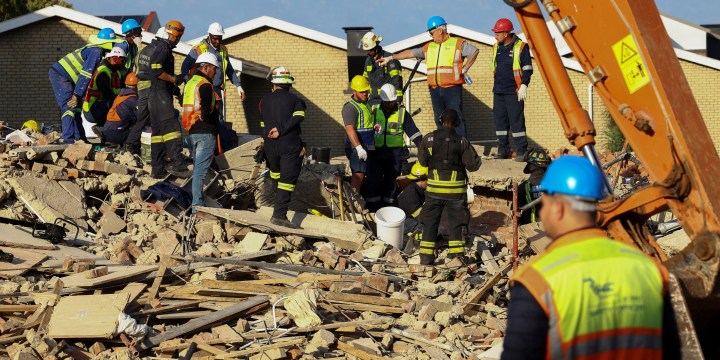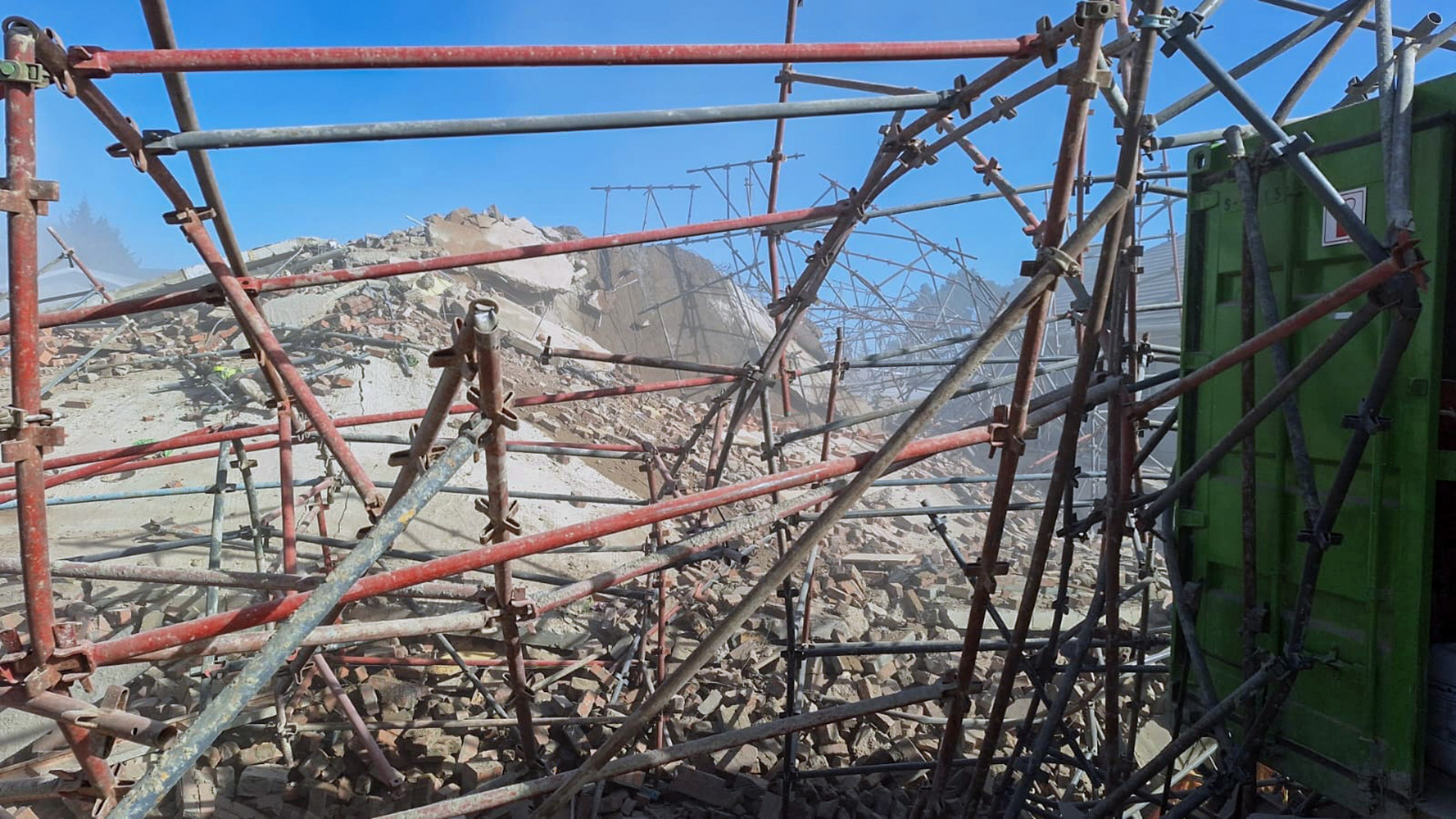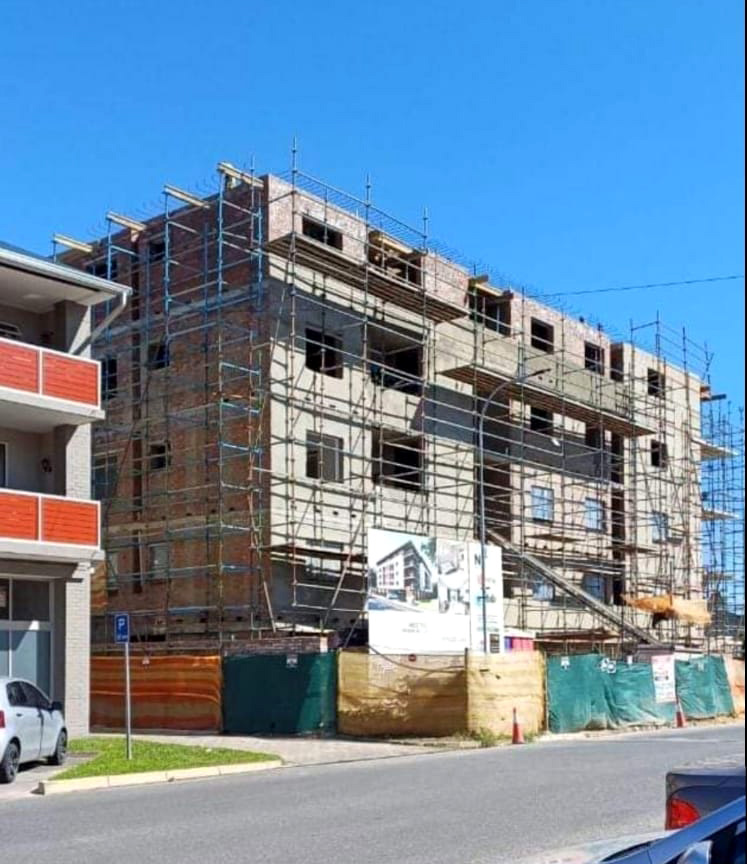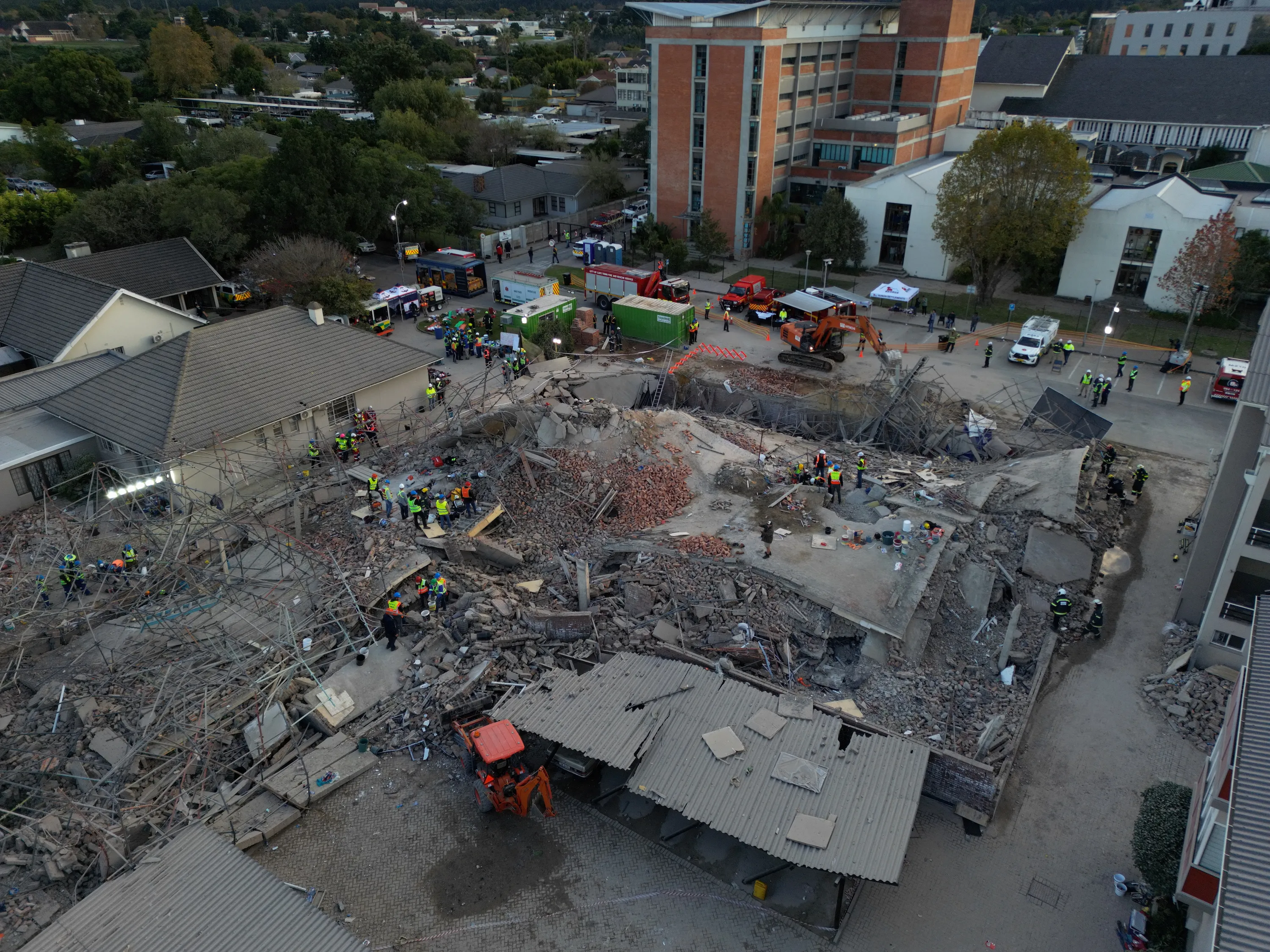CONSTRUCTION SITE DISASTER
New information shows 81 people were on George building site at time of collapse

The number of people who were on site at the time of the George building collapse is now believed to have been 81. With 37 removed from the rubble as of Thursday morning, this leaves 44 victims unaccounted for. The rescue effort continues.
Thursday morning update
On Thursday at 6am, the Garden Route District Joint Operational Centre in George announced that more people were trapped in the rubble of the collapsed building than initially estimated.
“The contractor has now confirmed that the number of workers on site at the time of the collapse was 81 (previously reported as 75),” it said.
“This follows intensive discussions and scrutinisation of the safety records with the responsible contractors.”
As of this morning, the number of workers retrieved from the site stood at 37, with eight of them confirmed to be deceased. Forty-four victims remain unaccounted for.
Authorities report that of the patients rescued from the site, 16 are in critical condition, six have life-threatening injuries and seven have minor injuries.
See our Photo Essay in Daily Maverick: Frantic search for dozens missing in George building collapse
The rescue effort has passed the 66-hour mark.
Switch to large machinery
On Wednesday afternoon, a change of strategy was announced in the efforts to rescue people from the rubble of the collapsed building in George, with a shift from the use of rescue equipment to large demolition machinery, including bigger concrete breakers.
However, Colin Deiner, the chief director of Western Cape disaster management services, said this did not mean they were switching from a rescue operation to a body recovery focus.

Part of the debris after the building under construction collapsed in George. (Photo: Stamhoof Brendon Torob Adams / Facebook)
Between Tuesday afternoon and the early morning of Wednesday, eight people were rescued from the collapsed building, most of whom were alive. This reinforced the determination of rescue workers to continue their life-saving efforts.
Read more in Daily Maverick: ‘I want my boy out of there’ — agonising vigil for families of those trapped in George building rubble
However, by 7pm on Wednesday there had been no further recoveries of living people, although another body was removed from the rubble. Thirty-eight of the initial 75 workers were still missing, with rescue efforts nearing the 55-hour mark.
“This building has provided us with a whole range of challenges from a rescue perspective,” Deiner said.
“Although we went [in] at high risk to save lives over the past two days, what is also important is our own people’s safety. The stage we are in now is a long and difficult one because we have to look for … bodies in a structure of five storeys that [has] collapsed.”

The building under constrution in George before it collapsed. (Photo: Stamhoof Brendon Torob Adams / Facebook)
On Tuesday, rescuers could communicate with some people beneath the rubble. Deiner said, “The responses we got [on Tuesday], we removed all those people. Most of them were alive right through the night. We had a very successful night in terms of removing people. But we don’t have any responses at the moment.”
Regarding the process of confirming the number of people in the building at the time of its collapse, Deiner explained that they had interviewed the contractor, supervisors and survivors.
“We have been able to build a picture of who was there and pretty much what they were wearing. We have overlaid that with the engineers … and that was a great help when we were doing the rescues over the last two days.”
Read more in Daily Maverick: What is known about Erf 15098, Victoria Street in George, the site of the deadly building collapse
Risky operation
Richard Walls, a professor of structural and fire engineering at Stellenbosch University, said the strategies for removing debris were being changed out of concern for the safety of the teams on-site.
“We have more than 3,000 tonnes of concrete there. We’ve got a structure that has collapsed, sitting precariously. You’ve got slabs at many angles being carried — and sometimes hung by the reinforcing steel in it — over to other parts of the structure,” he said.
“We’ve got large amounts of concrete that they’re trying to break through to get access to the voids where people may be trapped. The challenge that we’re having is just the sheer quantity of demolition that they’ve got to go through. With the tools available it’s been a slow process.”

A drone view of the scene where the building collapsed in George, trapping construction workers. (Photo: Reuters / Shafiek Tassiem
Walls said at one point during the day the slabs of concrete began moving again, with a large crack opening up where rescue teams were working.
“The teams are being pulled off that area and alternative strategies are being found to try to give access. The work will continue in various places, trying where we can to get in,” he said.
“This is far beyond just a search and rescue in terms of small equipment to get to people. With thousands of tonnes of concrete, large equipment is being brought in and we’re going to try to work systematically.”
The investigation
Western Cape MEC for Local Government and Environmental Affairs Anton Bredell said it was too early to give any updates about the investigation into the cause of the building collapse.
“We must give the engineers the space to determine the facts. We do have engineers on the site. We want an independent investigation and then the consequences will follow after that,” he said.

Chris Roos, a George advocate specialising in engineering and construction law. (Photo: Tamsin Metelerkamp)
Daily Maverick spoke to Chris Roos, a George advocate specialising in engineering and construction law, about what this type of investigation would entail. While his firm is not involved in investigating the Victoria Street building collapse, it has investigated other construction incidents.
“When these types of buildings collapse, the investigations typically take anything from 18 months to longer. If you take this project, it typically starts from a contract — the traditional contracts that will be used for these types of dwellings are what they call a JBCC [Joint Building Contracts Committee] contract and in that, there are very specific roles and duties and liabilities,” he said.
When conducting this type of investigation, Roos said they usually started with the architectural design, before moving on to the structural design and the functions of the structural engineer.
“From that point, we will then move over into the fabrication and manufacturing space to see what processes were followed — quality control, quality checks, verification, validation. And then, ultimately, we will move into the construction site itself and there, typically, there’s a lot of questions that need to be answered,” Roos said.
“We will look at things like attendance registers, site diaries, general workmanship [and] whether the necessary inspections were performed by the architect.”
Samples of the structure, such as the concrete used in construction, would usually be sent to laboratories for analysis.
Any liability on the part of the architect or engineer would depend on whether they had acted in line with their mandate and code of conduct, Roos said, though he added that these professionals were usually held to a “far higher level of accountability” than others.
He said it was possible that multiple parties involved in the project could be held accountable.
“There will be some form of an insurance claim against the contractor, potentially. There are potential claims that can flow through on to the architect, the engineer,” he said.
“These days, parties in building or engineering contracts can be held criminally liable. It all just depends on … the developer, ultimately the client, and then the families [of the workers] as well. A lot is going to depend on how the contractor conducted himself and whether he actually complied with the law in the execution of the works.” DM


















Am I right when I say collapse of buildings in SA is a rarity? I’ve never heard of one, other than this one. What I find puzzling though (having been a builder myself for many years) is the total collapse, and the amount of small bits of rubble visible on the pics. The scene looks like an implosion, actually. And there are so many checks & balances with the engineers, architects and building inspectors I find it hard to believe no warning signs like cracks etc. were detected. What a disaster!
Seems to me that the move is now essentially to recover the deceased a.s.a.p., hence the use now of larger removal equipment.
What asorry tale.
Sad indeed, it does not help that the contractor did not know the number of people on site.
I doubt any safety interventions were applied prior to incident as no register of attendance was furnished.
An 18 year old Malawian who had been in the country for 5 days is part of the missing, this deepens the questions of the contractor and property owner’s relationship with various legislations.
Shockingly the department of labour is silent on inspections yet their main role is to regulate the human element in these entities and would be expected to arrive first in these incidents.
Again the DA must be commended for the honesty on the critical things that were evidently missing from the scene.
Jobs must not just be a campaign slogan disturbingly used by the 70+ parties registered for elections.
I hope the Investigators are measuring those slabs before the heavy equipment destroys the evidence? The normal thickness used for reinforced concrete slabs in South Africa is 170 mm for small slabs, 255 mm for slabs larger than 5m x 5m and 340 mm thick for long-span slabs forming part of a beam and carrying heavier loads. Looking at Pictures of Rescuers posed on top of the collapsed slabs – Presuming the guy standing there is 6 ft tall and floor to knee is 500mm, I estimate those slabs are only slightly more than one third of 500mm, i.e. 170mm – those spans are way more than 5 metre spans. If this is the case, I can understand why it collapsed like a pack of cards. At the same time, the density of the concrete must be determined before it’s conveniently disposed of. Criminal charges must be brought.